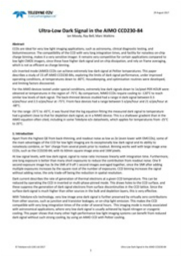Ultra-Low Dark Signal in the AIMO CCD230-84
CCDs are ideal for very low light imaging applications, such as astronomy, clinical diagnostic testing, and bioluminescence. The compatibility of the CCD with very long integration times, and facility for noiseless on-chip charge binning, makes it a very sensitive imager.
It remains very competitive for certain applications compared to low light CMOS imagers, since these have higher dark signal and on-chip dissipation, and rely on frame averaging, which is not as efficient as charge binning.
Download this whitepaper to learn more.
Read More
By submitting this form you agree to Teledyne e2v contacting you with marketing-related emails or by telephone. You may unsubscribe at any time. Teledyne e2v web sites and communications are subject to their Privacy Notice.
By requesting this resource you agree to our terms of use. All data is protected by our Privacy Notice. If you have any further questions please email dataprotection@techpublishhub.com
Related Categories: Connectors, cooling, Power


More resources from Teledyne e2v

Freeing high speed CMOS line scan cameras from the frame grabber
For some decades now, line scan cameras based on just one or two lines of pixel sensors have become well established in machine vision applications...

Ultra-Low Dark Signal in the AIMO CCD230-84
CCDs are ideal for very low light imaging applications, such as astronomy, clinical diagnostic testing, and bioluminescence. The compatibility of t...

CMOS Image Sensors are entering a new age
In the early 90's, it was suggested that Charge Coupled Devices (CCDs) were in the process of becoming extinct and considered to be ‘technologica...
